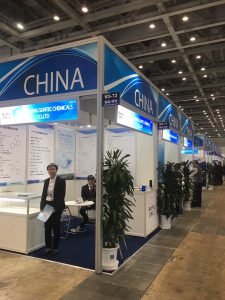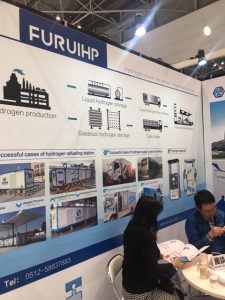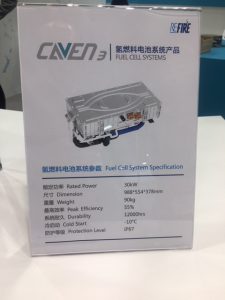Yuriage, Fukushima, Japan—Wrecked fishing boats, battered houses and toppled tombstones are nowhere to be seen seven years and two months after a giant tsunami swallowed much of this once sleepy fishing town. For centuries unknown, residents would pray to the sun rising on the Pacific Ocean horizon before the giant trembler struck the area, killing more than 1,000 people and leaving tens of billions of yen in damage. Now, the area luminesces with housing and business developments and belies that the future looks set to be better than before the earthquake. Except that
the vista is blocked double layer like with feudal era moats, by a seemingly endless seawall looming as high as 21 feet and a road being constructed half a kilometer inland that is going to be as high as the seawall when completed several years later.
Residents, most of them long-timers in the area, look eager to reestablish themselves in the area, which is famous for one of Japan’s best quality Akagai ark shell clams that sushi chefs vie for from across Japan. Fishermen sell part of their catches of Akagai, flounders and other varieties of fish at the Yuriage Asaichi market, which has become a popular tourist destination over the past few years. More fishing boats seem to be moored at the new harbor as farmers on tractors afar inland are seen busy tilling fields and so too are workers at more than half a dozen or so fish product processing factories near the harbor. And farther inland, new housing complexes have sprouted up proudly. Yuriage’s rebuilding work is headed for completion and residents are coming back.
But is this really necessary? Could it have been better not building the seawalls and the fishing harbor and condominium buildings, and instead, relocate people and businesses to higher-ground inland areas? After all, Japan is a country with rapidly shrinking population. Expensive social infrastructure being built is not likely to be put to active use over the coming years, and if so, why the country is building expensive infrastructure?
Yet, ‘reconstruction has reached a stage where people can see the progress for themselves,’ Shiro Yamada, mayor of Natori City where Yuriage is located, said in a March 6 interview with a local newspaper, Kahoku Shimpo. Yamada said there are now 9 fish processing companies operating at Yuriage’s fishery compound.
Before the quake, Yuriage residents totaled 5,700 forming a vibrant fishing-farming community, according to officials of the Natori City Office and Miyagi Prefecture government. Yamada said the city’s target is to keep the Yuriage population at more than 2,100 – a far cry from the pre-quake population. Natori City’s website shows that the Yuriage population in March 2017 – the most recent data – was 2,147, of which 36.75 percent were over 65 years old – and the population 石decreasing as old folks die and the inflow of young people remains slow.
Reconstruction, as Yamada insists, is progressing but has yet to be completed as the city and the prefecture are in process of building more public structures such as town halls, a sports arena, and a bicycle sports center, the facilities that Yamada hopes would lure young people back to Yuriage.
A macro view is that it has taken more than seven years since the March 11, 2011 earthquake for reconstruction work to the stage that people can tangibly see progress as Yamada says; residents have returned, as the mayor insists, but to less than half of the previous population and the growth is stalling; and for reaching the reconstruction stage to date, an unknown but a huge sum of taxpayer money has been spent raising questions as to how the aging and decreased population can pay back and how reconstruction projects have been decided and executed.
Asked by The Prospect recently, one Mr. Hishinuma of Natori City Office’s Reconstruction Coordination Division said the city does not have, for example, the overall cost data of a local highway – Shiogama-Watari Road – that’s now being built on a raised platform to avoid being submerged into a future tsunami. He said that reconstruction work jurisdiction is spanned over the city, the prefecture and the state in a complicated way that simple math cannot be applied to calculate the cost. Mr. Hishinuma also said jurisdiction for seawall and Yuriage fishing harbor construction work, which is nearly completed, is also stretched to the three authorities plus a local fishery association. A Miyagi City Office River and Ocean Division official, one Mr. Numasawa, told The Prospect an identical reply to the Natori official, saying that the prefecture has not tried aggregating budgets and expenditures of each authority plus the fishery association. ‘We do not calculate the total cost of reconstruction at Yuriage and other areas of Miyagi,’ he told me.
The two officials implicitly admitted that many administrative procedures overlap and result in producing similar documents drafted by prefecture, city and town officials, and therefore, leading to extra administrative costs. A possible example: In January 2018, the Natori City Office unveiled the 73-page ‘Yuriage District Inner City Reconstruction Plan.’ While it is not easy to confirm, Miyagi Prefecture is known to have drafted a similar document and ditto with the national government. Effectively, it amounts to wasting precious taxpayer money by producing similar documents and for the bureaucracy side, it means more work public sector workers.
During the six years of 2011-2015, the Japanese government budgeted and disbursed 26.3 trillion yen (USD239 billion) for earthquake reconstruction projects by collecting a reconstruction tax levy, sales of government-held Japan Post stock shares, trimming social welfare and other government expenditures. Japan would likely have to spend even more money for completing reconstruction, which is not expected in the near future, as the de-commissioning of Tokyo Electric Power’s Fukushima Dai-Ichi remains unknown pending the locating and extraction of missing nuclear fuel rods that almost triggered a meltdown.
In Minami Sanriku Town, about 100 kilos north of Yuriage, an old harbor which was washed away by tsunami was rebuilt, and swings, jungle gym, and other kid play equipment dot a manicured lawn park where no local children are playing. Nearby, a construction crane is humming, scooping gravel and soil to raise the platform for building a tall seawall. An old lady who was working in her garden said that when reconstruction workers are gone, visitors staying at local inns are expected to decrease. She said some inn owners did not reopen their facilities after the earthquake expecting fewer visitors to the region. Here too is confronted by old age and a shrinking population, and reconstruction work goes. For who?
If not all, much of earthquake reconstruction amounts to creating work for national and government officials. The Miyagi prefecture office is recruiting temporary, 3-year not-renewable contract civil engineers for a monthly pay of 219,444 yen to 280,241 yen, varying by age. The sums are believed to be about half of what regular – so-called career – workers are paid. Miyagi prefecture’s 2016 budget showed tight budget conditions resulting from the issuance of municipal bonds to pay for reconstruction.
Graphically, many municipalities hit by the earthquake – and Japan as a nation – are experiencing what Yubari City in the northernmost main island of Hokkaido had undergone several years ago: The city with population of 10,900 went into a national government receivership in 2007 for failing to repay municipal bond debt. As it continues to pay debt, the city axed all conceivable part of its spending, most notably halving city office officials’ pays including the mayor’s. Residents also suffered enormously as the city increased taxes, utility and other public service rates sharply. There’s no prospect of quick turnaround for its finances. Still, Yubari attracted national attention for axing city office officials’ salaries, which probably were higher than Yubari’s private sector pays before it went into a virtual bust.
If Yuriage and Yubari are tackling with their problems in earnest, there is a tiny island village in Tokyo with only 163 residents and as many as 24 village office employees and 6 village assembly representatives. Aogashima Village, about 350 kilos south of the city, has an annual budget of 1 billion yen (USD9 million). Village employees are paid the lowest salary among Japanese municipalities but highest per resident, according to a survey of Toyo Keizai magazine publisher. In recent years, dozens of inappropriate budget allocation cases for building what residents had argued as unnecessary – like the Yuriage infrastructure – surfaced, and one village official resigned.
About half of the 163 residents are migrants from other parts of Japan and engaged in public-sector works such as contract workers for the village office and teaching in grade schools, as well as construction sites. The 163 residents are relatively young and the ratio of people over 65 is also relatively small, according estimates based on Tokyo municipal government statistics. Since they are believed to be minor taxpayers, much of the village’s annual budget is transfer taxes from the Tokyo government and the central government.
Yuriage and Aogashima are classic cases of an old adage: If you want to lead a stable life in Japan, become a public servant and create jobs for yourself, and upon retirement, run for legislative posts.
###



